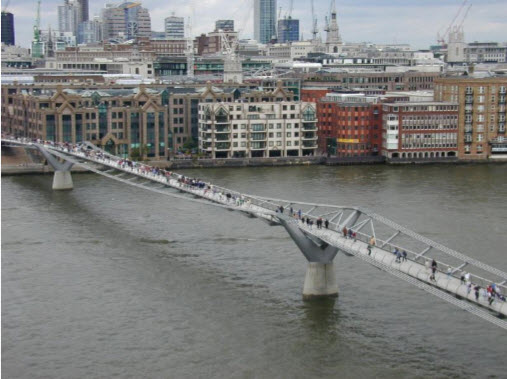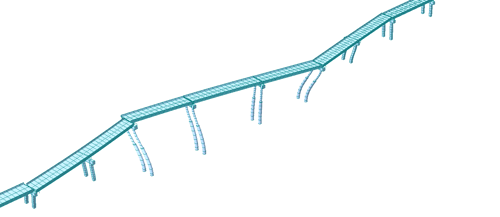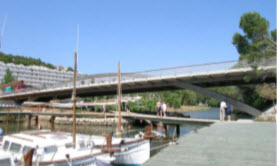Dynamic behavior of pedestrian bridge: Case Study

Author: Luciana Farias
Publish Date: 4 Sep, 2019
T.P. (Tim) van der Wardt
"Summary
Over the last twenty years, the tendency in bridge design has been towards greater spans and decreased stiffness and self-weight. Higher resistance of the materials used and improved detailing techniques means more highly stressed structures, smaller cross sectional dimensions and larger span length. As a consequence, the natural frequency (and damping) is getting smaller and the bridge structure becomes more sensitive to dynamic loads. This all is getting more critical for bridge elements, as a large number has natural frequencies that coincide with the relevant frequencies of the human-induced dynamic loading (and wind loading). Especially footbridges have a potential to suffer excessive vibrations under dynamic loads induced by pedestrians.
In this thesis a 2 span arch bridge of 84 m called Vijfwal is dynamically analysed and dynamic improvements are proposed and analysed in order to improve its vibration serviceability. The main objective of this Master’s thesis is to analyse the vibration serviceability of an existing designed steel arch bridge in the city of Houten using the Eurocode guidelines. Preliminary calculations showed that the bridge is sensitive for human induced dynamic load. In other words: a preliminary modal analysis turned out that the natural frequencies of the bridge are in the critical range of the normal walking frequencies of pedestrians. So a dynamic analysis is required in order to compute the real responses of the bridge deck. Acceleration is the parameter most commonly used to check the vibration serviceability of a bridge, so one has to check if the responses satisfy the Eurocode norms (EN 1990).
Firstly a study of literature is worked out in order to understand humans as vibration source for footbridges, footbridges as dynamic systems and also the interaction between humans and bridges. Besides this, also measures that can be taken in order to improve the dynamic behaviour of bridges are studied. Hereby one has looked to existing footbridges with vibration serviceability problems and their measures (Millennium bridge and the Zouthaven bridge).
Footbridge Vijfwal is modelled in MIDAS/ Civil, a finite element program of TNO Diana. With MIDAS/ Civil two analyses are performed: Firstly a modal analysis to compute the natural frequencies of the bridge and the coinciding vibration mode shapes. Secondly a transient analysis is performed to determine the accelerations of the bridge deck, when it is loaded by dynamic load models of the Eurocode and an alternative moving load model, whereby the pulsating load is travelling along the bridge deck.
The results of the modal analysis turned out that the first two natural frequencies possibly may be excited by human induced load. Namely: • Mode-1: the first torsion mode ft1=1.7 Hz and • Mode-2: the second vertical bending mode fb2=3.1 Hz Because these frequencies are in the critical range which should be avoided by the frequency tuning method (this means avoiding critical frequency ranges that could be excited by moving pedestrians), vibration serviceability problems are to be expected (e.g. acceleration response does not satisfy the Eurocode comfort criteria). So the responses have to be computed in a transient analysis, in order to check the serviceability state.
For the computation of the responses of the bridge deck when loaded by pedestrians the Eurocode-1 Annex X dynamic load models are used. The Eurocode-1 considers three dynamic load models to simulate human induced load: DLM1 dynamic load model due to 1 pedestrian, DLM2 dynamic load model due to a small group (which simulates also pedestrians who synchronise their movement with the bridge deck) and finally DLM3 to simulate a continuous stream of pedestrians. These dynamic load models simulate the time dependant human induced force by the first harmonic of a Fourier series, with components in the vertical and horizontal-lateral direction. The Eurocode-1 stated that only the vertical natural frequency nearest to 2 Hz, and horizontal to 1 Hz has to be checked in a transient analysis. Because this coincides with the mean values of the normally distributed vertical and horizontal-lateral footfall frequencies for normal walking.
With these loads the vertical and horizontal accelerations of the bridge deck are determined. To guarantee the comfort of pedestrians on the bridge the criteria of the Eurocode EN 1990 aims that the accelerations do not exceed: ay≤0.2 m/s2 (horizontally-lateral) and az=0.7 m/s2 (vertically).
Because the Eurocode-1 Annex X, requires that the structure has to be loaded in its natural frequency at its most unfavourable location on the bridge deck, the computed accelerations are probably overestimated. Therefore, the acceleration response of the bridge deck is also computed when the bridge is loaded by an alternative moving loading model based on the Eurocode dynamic load models: hereby the pulsating human induced force with components in both vertical and horizontal-lateral direction is travelling along the bridge deck, so only for a short time the structure is loaded at its most unfavourable location for the vibration mode under consideration.
The maximum acceleration responses of the bridge deck due to the two dynamic load models are as follows: • Eurocode-1 Annex X: Decisive load model DLM2: ay=0.92 m/s2 az=0.61 m/s2. • Moving load model: ay=0.33 m/s2 az=0.21 m/s2.
Also with the alternative travelling load model, the horizontal acceleration of the bridge deck does not satisfy the criteria. The first torsion mode is the governing vibration mode for footbridge Vijfwal. So measures have to be taken in order to satisfy the requirements of comfort.
The effect of four types of improvements for footbridge Vijfwal are investigated: • Geometrical changes • Adding stiffness or adding dead mass • A combination of adding stiffness and mass • Placing of tuned mass dampers (TMD’s)
Although for the alternative moving load model, the structure can satisfy the codes by simply adding vertical stiffness or adding dead mass in the primary arches, the structure has to be checked according to the Eurocode-1 Annex X dynamic load models, which are very conservative. This is because the Eurocode1 prescribes to place the human induced load at the most unfavorable location on the bridge deck, in its natural frequency and also all synchronized people are located at this position on the bridge deck. In reality synchronized people are distributed along the bridge deck and non perfectly walking in the natural frequency of the bridge.
So one argues to use the alternative moving load model, where people are travelling over the bridge deck, and only for a very short time the structure is loaded at its most unfavorable location, also people who synchronize their movement with the bridge deck are distributed.
However, to fulfil the requirements of the Eurocode EN 1990 when the structure is loaded by the dynamic load models of the Eurocode-1 only a combination of adding stiffness and adding mass can result in satisfying the vibration serviceability requirements. Adding diagonal hangers in combination with adding dead mass in the primary arches turns out to be the best solution. The mass can be added by filling the arches with for example sand.
Because the torsion mode is governing one could think of alternative solutions like placing the cycle-tracks at the outside and the foot path in the middle of the bridge deck, in this way it is less likely that the torsion mode gets excited. Also by using the alternative load model to compute the maximum accelerations of the bridge deck the comfort criteria can be satisfied by placing TMD’s at half of the main span, horizontally placed at both sides of the deck."



Add a Comment